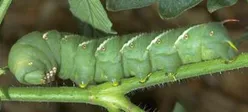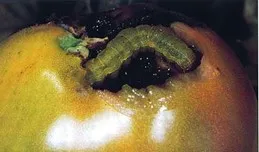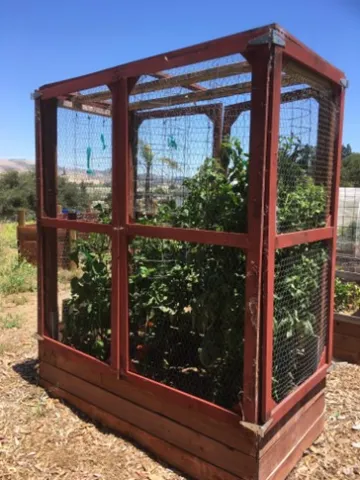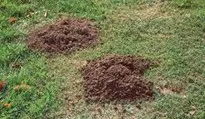By Kim Wilson, UC Master Gardener
The Small Guys
Tomato or Tobacco Hornworm
Identification
|   |
Damage
- Larvae chew and consume leaves and new stems. The adult moth does not cause damage.
- Caterpillars may damage green or red tomato fruit. This damage consists of broad surface defects but no distinct holes.
- They also may feed on potatoes, peppers and eggplant.
Management
- Handpicking or snipping with pruning shears (I don’t know which is worse) is quite effective in home gardens.
- Small parasitic wasps help control hornworms by laying eggs on them. If you see a hornworm with white pupal cases on its back, leave it alone. The wasps will kill the caterpillar once they hatch and parasitize more hornworms.
- Bt (Bacillus thuringiensis) is an environmentally safe microbial insecticide composed of bacteria that kills only caterpillars eating the leaves. Bt will not harm beneficial insects, animals or people. Bt works best when the larvae are small and the Bt is fresh. Bt stored for more than a year may not be as effective.
Tomato Fruitworm
Identification
|  |
Damage
- Unlike hornworms, fruitworm damage is primarily to fruit.
- Prefer green fruit causing neat round bore holes adjacent to the fruit stem. Bores deep into fruit creating watery tunnel with droppings (frass).
- Damage causes premature ripening of fruit.
- Larvae will also bore into red fruits.
- If no fruit present, larvae may feed on leaves, but this is minor and stops once fruit forms.
- Fruitworms (also called corn earworms) feed on many plants including corn, bean pods, lettuce, peppers and eggplants.
Management
- Prevention- avoid planting tomatoes near corn
- Sanitation- remove and dispose of infested tomatoes
- Handpick larvae and place in container of soapy water.
- Insecticides such as Bt are not as effective due to larval location inside tomatoes.
Snails and Slugs
Identification
- We all know what these guys look like- enough said.
- Presence of glistening shiny slime trails may be a clue to their activity.
Damage
- Surface to deep surface damage to red fruits, primarily to tomatoes on the ground as opposed to throughout the canopy as with hornworms.
- Leaf damage is not an issue for tomatoes.
Management
- Sanitation includes keeping tomatoes from touching the ground. We don’t want to make it too easy for these guys. Clean up any potential hiding places.
- Manual removal is key. They are most active at night. For the brave gardeners, inspect garden at night with flashlight and handpick the snails, dropping in soapy water or a bag.
- For those wanting to avoid the spooky night garden experience, search for snails during the day under plants and any nooks where they may hide.
- Trapping is also a good option. Place upside down melon or citrus rinds, rolled up damp newspaper or boards in garden and inspect every morning for hiding snails. Shallow tuna cans or tart tins filled with beer, with lip of can at soil level will attract these pests.
- Snail baits are also an option.
The Large Critters
Identify the Pest
- Where is the damage? Low to ground (under 2 feet) or high to ground (above 2 feet).
- Type of damage, plants involved, evident bite marks, characteristics of cut edges of leaves or fruit.
- Time of day damage occurs, night vs. daytime.
- Clues such as trampled plants, droppings or tracks, ground holes, mounds or paths through grass.
Ground Squirrels
- When active: Midmorning to late afternoon and they love warm sunny days.
- Plants affected: Tree nuts, fruits, vegetable seedlings, bark of shrubs and trees, many vegetables including ripe tomatoes, squash, cucumber, beans and eggplant.
- Damage and clues: Open ground hole. Eaten tomatoes on vine or pulled off plant. Often eats only a few bites before discarding.
- Management: It is crucial to coordinate the management method to life cycle and behavior of ground squirrel. Can include trapping, fumigation, toxic baits, destroying old burrows and shooting, depending on your location and time of year.
Gophers
|
|
Roof Rats
- When active: Most active at night. Good climbers, seen running along utility lines and fence tops at night. Live in trees or attics.
- Preferred food: Fruits, nuts, berries, slugs and snails. Rats love avocados and citrus.
- Damage and clues: Characteristic feeding patterns - oranges have small hole with pulp eaten leaving a hollowed-out rind hanging on tree; lemon with entire rind eaten and remainder of fruit left on tree. Rats will leave damaged tomatoes on vine.
- Management: Sanitation, habitat management and trapping. Maintain tight-fitting garbage lids, leave no pet food outside, thin vegetation, remove overhanging vines, hedges and tree branches near garden.
Birds
- When active: Daytime
- Plants affected: Ripening fruits and nuts, leafy greens, berries.
- Damage and clues: Leafy greens show ragged torn edges or holes avoiding leaf veins. If all emerging bean or pea seedlings disappear, birds are likely. Ripening tomatoes near ground show conical punctures like pencil jabs.
- Management: Protect seedbeds and emerging seedlings with row covers. Bird netting over a frame (½ inch PVC pipe arch) that is secured at ground level. Cover vegetable beds with cages of chicken wire or hardware cloth.
Raccoons
- When active: night. Get a strong flashlight and shine into garden at night. You may see a group of glowing eyes staring back at you.
- Plants and food sources: Corn is their all-time favorite. Will eat berries, nuts, fruits and vegetables and pet food. They are omnivorous so they also eat snails, eggs and small animals. Tomato damage is like ground squirrel damage.
- Management: Like rat control, secure garbage cans, no pet food outside and pick up fallen fruit and nuts. Remove woodpiles, no trellis or arbor or overhanging tree branches near house. Exclusion is key: ordinary fences are usually not effective, but raccoons are sensitive to electric fences. Small portable electric fence kits powered by solar are available for this purpose and consists of 2- 3 wires, available at garden centers and online.
Deer
- When active: Early morning and evening.
- Plants affected: Almost everything: vegetables, fruit, nut and ornamental trees and shrubs. They love young fruit tree leaves.
- Damage and clues: Bites to tomatoes will be in the top of the tomatoes instead of the sides and they will trample plants. Look for tracks. Deer rip leaves so leaf edges are torn and jagged.
- Management: Fence- tall fence- a really tall fence about 9 feet height. A dog can be helpful.
| If all else fails, use this… |  Photo credit: Jenny Durling, UC Master |
References
- Birds, Mammals and Reptiles (Vertebrate Pests). Homes, Gardens, Landscapes and Turf. UC IPM. Pests in Gardens and Landscapes: Vertebrate Pests—UC IPM
- Managing California Ground Squirrels. Ground Squirrel BMPs. UC ANR. California Ground Squirrels - Ground Squirrel BMPs - Ground Squirrel BMPs
- Problem Wildlife in the Garden and Yard. National Pesticide Information Center. Problem Wildlife in the Garden and Yard
- Pests in Gardens and Landscapes
- UC IPM. Managing Pests in Gardens: Vegetables: Invertebrates—Hornworms
- BT for Caterpillar Control. IPM INFO. UC Vegetable Research and Information Center. IPMINFO
- Tomato Fruitworm. UC Pest Management Guidelines. UCIPM
- Tomato Fruitworm / Tomato / Agriculture: Pest Management Guidelines / UC Statewide IPM Program (UC IPM)
- Reference: Snails and Slugs. Pests in Gardens and Landscapes
- UCIPM. Snails and Slugs Management Guidelines--UC IPM

